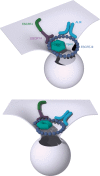ESCRTs are everywhere
- PMID: 26311197
- PMCID: PMC4601661
- DOI: 10.15252/embj.201592484
ESCRTs are everywhere
Abstract
The ESCRT proteins are an ancient system that buds membranes and severs membrane necks from their inner face. Three "classical" functions of the ESCRTs have dominated research into these proteins since their discovery in 2001: the biogenesis of multivesicular bodies in endolysosomal sorting; the budding of HIV-1 and other viruses from the plasma membrane of infected cells; and the membrane abscission step in cytokinesis. The past few years have seen an explosion of novel functions: the biogenesis of microvesicles and exosomes; plasma membrane wound repair; neuron pruning; extraction of defective nuclear pore complexes; nuclear envelope reformation; plus-stranded RNA virus replication compartment formation; and micro- and macroautophagy. Most, and perhaps all, of the functions involve the conserved membrane-neck-directed activities of the ESCRTs, revealing a remarkably widespread role for this machinery through a broad swath of cell biology.
Keywords: exosome; exovesicle; nuclear envelope reformation; plasma membrane wound repair; shedding microvesicle.
© 2015 The Author.
Figures




References
-
- Baietti MF, Zhang Z, Mortier E, Melchior A, Degeest G, Geeraerts A, Ivarsson Y, Depoortere F, Coomans C, Vermeiren E, Zimmermann P, David G. Syndecan-syntenin-ALIX regulates the biogenesis of exosomes. Nat Cell Biol. 2012;14:677–685. - PubMed
Publication types
MeSH terms
Substances
Grants and funding
LinkOut - more resources
Full Text Sources
Other Literature Sources
Miscellaneous

